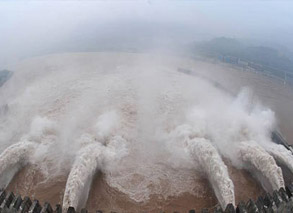2009, bumpy ride for oil
2009-12-23 08:38 BJT
By Xinhua writer Yang Lei
NEW YORK, Dec. 22 (Xinhua) -- The world thought oil market would take a breather this year -- after all, it's expected to be more quiet after a rollercoaster wing ranging from nearly 150 U.S. dollars to just above 30 dollars.
But the real movement demonstrated that we haven't seen it all. To some extent, energy market has been more volatile in 2009 than the year before.
Oil prices were hovering around 35 dollars until early February. On Feb. 12, 2009, crude futures dropped to 33.55 dollars a barrel on New York Mercantile Exchange (NYMEX), about 77 percent lower from the all-time high of 147.27 dollars reached in July 2008.
Just as people were trying to enjoy the cheap oil, prices took a U-turn and rallied through summer and fall. And on October 21, NYMEX crude futures settled above 80 dollars a barrel for the first time this year.
The price change in dollar might seem a bit mediocre compared with those triple digits in 2008. But the change in percentage has just been as dramatic. Oil prices gained more than 40 percent in the three months between April and June, marking the highest quarterly increase since the third quarter of 1990.
Oil had experienced fluctuation that would normally happen in two years in the first six months this year, Raymond Carbone, president of Paramount Options, told Xinhua.
Expectations for an economic recovery has been the main theme in oil, along with many other markets. For example, equity market was on a similar track which has rallied since the early March lows.
Oil market investors were focused on the resurgence of demand in the future instead of current supply-demand conditions. After huge amount of money injected into world financial system and various stimulus packages launched by governments, investors were glad to see the "green shoots." In United States, the largest oil consumption country in the world, the gross domestic production increased at an annual pace of 2.2 percent in the third quarter, the first positive growth in two years.
Another big player behind the scene is the dollar. The inverse correlation between oil and the greenback has been at history high levels this year. Crude oil prices declined at the beginning of the year when investors flighted to the safe haven of dollar. And the price hike took stage the same time as the dollar started to weaken against major currencies.
"Market participants embraced the idea that the worst of the financial crisis had passed which would have resulted in an eventual increase in demand for oil as the economic recovery gained momentum," Conley Turner, Wall Street Strategies' senior research analyst, told Xinhua. "As such, they pared back their dollar holdings in order to increase their exposure to more risky assets."
Oil's losses in December proved to be a perfect showcase of dollar's influence. Speculations of a possible interest rate increase by the Federal Reserve has sent the green back rising at year end. What happened in oil? Prices fell for nine straight sessions and briefly touched below 70 dollars.
Looking ahead, recovery and dollar will continue to dominate the energy market. There are good reasons to be bullish about oil prices. International Energy Agency, OPEC and U.S. Energy Department Energy Information Administration have all upward adjusted their forecasts for the world fuel consumption in 2010.
"Long term expectations are for the price of this essential commodity to be markedly higher," Turner said. Investment bank Goldman Sachs predicted oil prices to rise to 90 dollars a barrel next year, while Bank of America-Merrill Lynch eyes an average of 85 dollars.
But it may not be a straight road. The recovery in 2010 will be "uneven" and emerging markets will "far outshine the advanced economies," as Harry Tchilinguirian, commodity derivatives senior oil analyst at BNP Paribas, wrote in a note to clients.
Asian economies are leading the way out of the global crisis but outside of that region the recovery is considerably less than robust, Turner said.
"While the worst of the crisis may have indeed passed across member countries of the Organization for Economic Development, the impact still endures and is likely to be felt well into 2010 and beyond," he added.
Moreover, the recent sovereign debt crisis in Dubai, Greece and several other European countries have cast a shadow on the already unclear future of the world economic recovery.
Oil prices are expected to spend more time in self-adjustment after hovering mostly in the range of 70 to 75 dollars for months. Perhaps the only certain thing about oil is to expect more uncertainty of it.
Editor: Xiong Qu | Source: Xinhua
 Mail
Mail Share
Share Print
Print


 Video
Video









 2009 China Central Television. All Rights Reserved
2009 China Central Television. All Rights Reserved